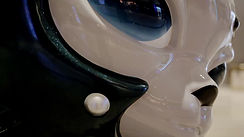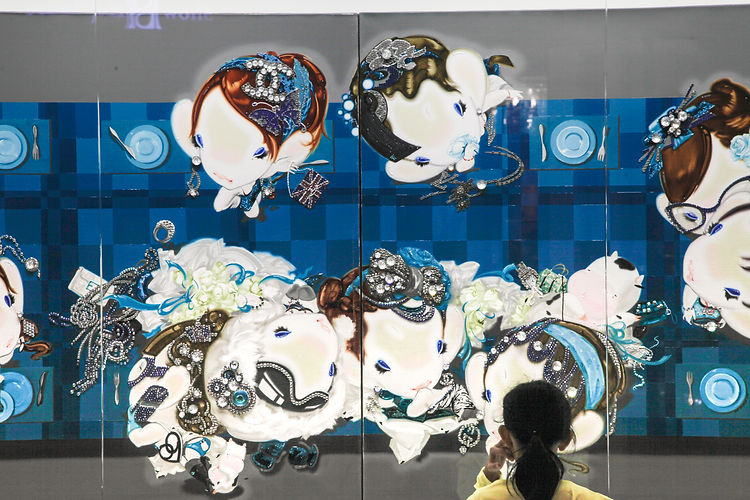
ART MACAO
For Art Macao 2019, Nissa Bella Art Management created an exhibition for Studio City about Japanese Anime.
To illustrate the long history of the art form, both in aesthetics and content, the show dwelled on Japanese woodblock prints (ukiyo-e). Artworks and graphics infused with ukiyo-e iconic patterns were commissioned.
The Heroes from the Edo period, Samurais, encountered their manga and anime counterparts.
To fit the Art Macao direction, contemporary art pieces were included, notably by artists who participated in the Venice biennale. And to create interactivity with the public and for the enjoyment of all audiences, an arcade wall free to play and an otaku room filled with collectible toys were created.
The visual references of Anime are present everywhere in Japan and abroad as a symbol of Japanese culture. Museums are devoting exhibitions to the genre of manga, like the British Museum in 2019. The topic is not only trending but also allows to reveal the roots in Japanese Visual culture from the Edo period of a genre that now pervades many forms of art from the book to the screen and contemporary art.
This exhibition took into account the constraints of Studio City's environment as well as the ones inherent to the theme (such as copyright). It was produced very efficiently and in a very short period of time.

MAP Office's Amanami Animated is a contemporary animation drawing from the roots of the Edo period in Japan, from ukiyo-e, and from the Japanese contemporary expression of the history, culture and traditions of the ama-san, the free divers’ who work in the Bay of Ise in Japan. This animation installation revisits the patterns and reimagines the genre of ukiyo-e, not as a technique, but as a fictional ethnographic representation of the coastal landscape during the Edo period.


In this contemporary interpretation of the ukiyo-e, the numerous drawing layers allowed by a computer are replacing the traditional wood block and coloured print processes.
In each panel, Amanami wears a different kimono with either an octopus or a sea-urchin printed on it. These kimonos were entirely produced by MAP Office for the project.
MAP Office is a multidisciplinary platform devised by Laurent Gutierrez (b.1966, Casablanca, Morocco) and Valérie Portefaix (b.1969, Saint-Étienne, France). This duo of artists has been based in Hong Kong since 1996, they contributed to the Venice Biennale five times (2000, 2003, 2007, 2008, 2010).
Modern Art Of the Floating World is a collection of works from two of JPS Gallery’s artists reinterpreting Japan's most influential visual genre, ukiyo-e, through a contemporary lens.
Horihiro Mitomo and Ukiyoemon Mitomoya incorporate two unique styles. Horihiro references and inserts the elements of modern trends, and this observational style has led to collaborations with many brands to bring ukiyo-e into the fashion world, leading to a wider inclusion of this traditional artform. Most of Ukiyoemon's works are based on the theme of life and satirical events. A recent series of paintings focuses on the life of the Japanese salaryman, and paints a picture of the sorrow of today’s working class.

The genre of ukiyo-e is a record of what has been seen and heard in life. Both artists use this retro-style painting technique to capture moments from the present, but with a nostalgic taste, evoking resonance and retrospection by the viewer.
Horihiro Mitomo (b. 1981, Japan) is both a renowned ukiyo-e artist and Tebori tattoo master. His fascination with ukiyo-e, and his desire to frame it in a modern setting, has led to many commissions which blend traditional Japanese culture with that of pop culture.
Ukiyoemon Mitomaya (b. 1981, Osaka). Most of Ukioemon’s works are based on life and satirical events, and his integration of ukiyo-e into contemporary culture makes this traditional genre more accessible and easier to understand.
Han Yajuan grew up watching anime and reading mangas. As a result, her early works are highly influenced by the aesthetics of Japanese anime. She is part of the “Cartoon generation” of Chinese contemporary artists. Her characters, all female, have disproportionate infantile bodies in the super cute kawaii style of Japanese anime. The large heads, absence of nose, small mouths, flat faces and especially the exaggeratedly wide eyes, are a feature of the genre of Japanese anime. The characters only companion is an inoffensive and nurturing little cow, almost a pet with polka dot like skin, the perfect sidekick/alter ego of the anime hero. Their eyes closed, these protagonists are engulfed in a dream, like in the virtual reality of anime. Their new material prosperity populates their dreamy state, as they are floating, with luxury items symbolic of consumer glamour and of adult life.

The artist’s generation grew up connected and the collective unconsciousness of aspirations is illustrated in her works, just like a story of heroines is told in anime. The vibrant colours are also inspired by the aesthetics of anime. The narrative, like in many anime, has an underlying social commentary. Shojo manga (comics for girls) is a Japanese form reflecting the Japanese girls expectations and desires, Han Yajuan’s works combine these aspects as she paints the newly empowered female consumer and the society in which she lives in. The technique reinforces the presentation of an ideal between reality and dream/myth.
Han Yajuan (b. 1980, Qingdao) is a painter, a sculptor and a video artist. Han Yajuan uses a simple and direct style that portrays the light-hearted themes of young people’s collective imagination, with a nod to the Japanese manga and anime dear to the Cartoon Generation. In later stages of her career, her works have evolved to explore the world of childhood and has also become more conceptual. Living and working in Beijing, she participated in the 54th Venice biennale in 2011.
Art toys have been first inspired by the hype of small plastic toys notably created in Tokyo by fashion designers. Designer toys often referencing the aesthetics of anime became extremely popular through toy companies, conventions, and websites. These objects have permeated the contemporary art market more recently as well, notably with figures like KAWS but also with highly established artists like Takashi Murakami. The success of these objects relies on a democratic approach to artmaking.
Rainbo was herself inspired by the Urban art scene and her iconic character Mr Waterloo, named after Waterloo Station in London, first came to life as a graffiti in Leake Street tunnel and as art, urban art and popular culture became more intertwined, grew into an art toy.

The figure of the monkey is prevalent in the Asian imagination, through the Monkey king story ("Journey to the West: 西游記"). Japanese manga and anime were also inspired by the Monkey King, with the famous character of Son Goku 孫悟空, from the Dragon ball series.
An oil painter, sculptor, graphic artist, and graffitist, Rainbo (b.Wunan) excels in character design and story writing. She lives and works in Hong Kong.
Urban art has also been influenced by the visual culture of manga and anime. From the lines, to the narratives and characters, the universe of anime has nourished the production of Street art and resulted in murals clearly identifiable as related to anime in Japan and beyond.

Yokohama artists Kensuke Takahashi and Tadaomi Shibuya collaborated on this immersive artwork which populates the room from the floor onto the wall. Kensuke Takahashi works in vibrant colours and the link between the natural world and mythology infuses his works. Tadaomi Shibuya has been inspired by Hip Hop culture, graffiti & classic Anime and Manga. Hi style has a distinct sci-fi visual identity, rendered more striking by the use of straight lines and shadows. This collective work illustrates the prevalence of anime aesthetics in all forms and genres of Japanese contemporary art.
Otaku room
The Japanese term otaku refers to fandom, it has several stories accounting for its origin and refers to a subculture focused first on manga and anime, as well as gaming and which developed beyond.
Otaku subculture itself became a central theme of various anime and manga works.
In a society ruled by hierarchy, from schools to work life, clubs and groups like otaku groups allowed the youth to belong differently and to find new communities with like-minded centres of interest.

The phenomenon led to the growth of neighbourhoods dedicated to the objects of desire of otaku, like manga books, anime series and films, posters, toys. The Akihabara area in Tokyo is famous for being a popular gathering site for otaku as it has many stores specializing in anime, manga, retro video games, figurines, card games. The toys, posters, books and other items on display here are all examples of iconic characters and series in Japanese anime. These objects have become collectibles.
Arcade room
Parallel and intertwined to anime culture, gaming has also grown as a major pastime in Japanese popular culture. It also has its iconic characters, it is sometimes inspired by anime, sometimes inspiring anime. It consists of quests with heroes at their centre. Visually, it has evolved from a pixelated aspect into a high resolution virtual reality.

From the maze of Pac Man (Namco), to the shooter genre of Space Invader (Taito), and the platform of Mario Bros (Nintendo) and Donkey Kong (Nintendo) are among the most famous globally.
One of the most ancient figures of the Hero in Japan is the Samurai, a military nobility and officer caste of feudal and early modern Japan. In Japanese, they are usually referred to as bushi (武士). The samurai is an iconic hero and warrior/knight figure that inspired the narratives of ukiyo-e and the quest and battles in manga and anime.

Among serving roles as news media, theatrical poster, book illustration, and advertisement, or travel guide, ukiyo-e played an important role in telling the news and historical event. Many ukiyo-e were produced with an order from the Samurai lord to tell how their ancestors came to rule the land by winning a glorious battle. (to give more authenticity to their ruling) also, it served as a record of the war.
Ukiyo-e telling stories of samurai lords and warriors, are called musha-e, "武者絵". They became popular entertainment after the Edo government became more strict on publishing erotic ukiyo-e (called shunga (春画)) around 1787-1793.
Ukiyo-e inspired popular and high art in Japan through stories and heores, as well as aesthetics.







